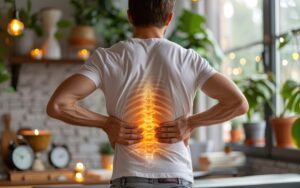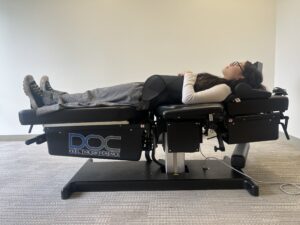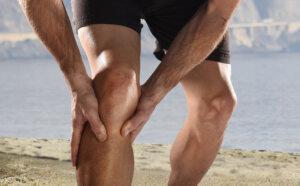Tennis Elbow is the most common cause of elbow pain, and despite its name, you don’t have to be a tennis player to get it.
What Is Lateral Epicondylitis or Tennis Elbow?
Lateral epicondilitis is a painful condition, caused by overuse of the elbow. It is also known as tennis elbow, due to the fact that around 50% of all tennis players will develop it. But you don’t have to play tennis to get it. Any repetitive gripping activities that involve use of the thumb and first two fingers may lead to this condition.
Lateral epicondilitis is a type of tendinitis – inflammation of the tendons. The tendons are bands of connective tissue that connects muscles to the bones. This condition can affect either dominant or not-dominant arm, but more commonly is affected the dominant arm and is characterized by pain on the outside of the elbow.
Tennis Elbow Causes And Risk Factors
Tennis elbow is muscle strain injury caused by overuse. The main cause for this condition are repetitive movements that result in stress and series of small tears in the tendons that attach forearm muscles to the outside of the elbow. These movements include straightening of the arm, and hand and wrist raising.
It is most common between ages of 35 and 50 years old, and equally affects both men and women.
As the name suggest, playing tennis is one of the possible causes of this condition. Other causes include:
- Other racquet sports
- Labor with utilizing heavy tools
- Repetitive grapping and lifting
- Gardening
- Painting
- Work in front of a computer
- Gaming
- Playing some types of musical instruments
- Cooking
Factors that increase the risk of lateral epicondilitis include:
- Age – It can affect people of all ages but is most common between 35 and 50 years old.
- Occupation – Does your job involve utilizing heavy tools and repetitive motions of the wrist and elbow? This may increase your risk of developing lateral epicondylitis.
- Racquet sports – Especially if you have poor stroke technique.
Tennis Elbow Symptoms
Tennis elbow often develops over a long period of time, and its symptoms also appear gradually. It is also common for symptoms to wax and wane over time, with flare-ups occurring during periods of increased activity. Symptoms usually include pain and stiffness, but sometimes symptoms may be non-specific, with the only indications of the condition showing up as a drop in athletic or work performance.
Main characteristics of pain are:
- It is located on the outside of the elbow
- Gets worse over a period of time
- Squeezing and shaking the hand increase the pain
- It can radiate to the forearm or hand
- Worse in the morning
Other symptoms may include burning sensation, difficulty gripping or holding items, touch tenderness of the elbow, morning stiffness, difficulty turning or flexing the wrist, etc.
Experiencing other Sports Injuries and pain, we’ve gathered some additional resources for you:
How To Diagnose Tennis Elbow Effectively
Usually the diagnosis can be made based on the history and physical examinations. Imaging tests such as X-ray and MRI, and EMG may be used to rule out other possibilities.
Your SF chiropractor will ask you how your symptoms developed, what’s triggering or worsening the pain, about your occupational risk, if you have history of injury or some king of arthritis, etc.
During the physical examination, the doctor will look for swelling and tenderness around the elbow. You may be asked to try to straighten your wrist and fingers against resistance with your arm fully straight to see if this causes pain.
Best Tennis Elbow Treatment
Tennis elbow is a condition that usually gets better on its own. There are many available treatment options, and not every treatment will work for every patient, so it is important to try as many options as needed until find the best for you.
Treatment options are generally divided in two groups, surgical and non-surgical. Up to 95% of patients with tennis elbow can be successfully treated without surgery.
Here are some of the options you should consider if you have tennis elbow:
- Rest – avoiding use of the affected elbow increase healing rate, and is important part of the treatment.
- Ice – applying ice or cold packs three times a day improve the pain and inflammation.
- Compression and elevation of the affected arm
- Over the counter painkillers – such as acetaminophen and NSAIDs, such as ibuprofen and naproxen, can provide relief for mild pain, while improving the inflammation.
- Corticosteroid injections – injecting a combination of corticosteroid and local anesthetic inside the elbow joint is used for more severe and chronic pain.
- PRP injection – PRP or Platelets Rich Plasma injections are accelerating the healing process of this condition.
- Ice massage (Cryotherapy) – is providing relief by reducing the inflammation. Ice is applied with circular movements, putting pressure directly on the skin.
- Ultrasound therapy – Ultrasound therapy is mostly used as a part of physical therapy to treat pain and to promote tissue healing.
- Physical therapy – including corrective exercises that focus on elbow movements. This treatment option improves the range of motion of the elbow and after a few treatments can improve the pain also.
- Chiropractic care – A recent studies have shown chiropractic treatment to be very effective for tennis elbow. Chiropractic treatment may include manual manipulation and instrument-assisted method to resolve the adhesions in the muscles and tendons.
- Acupuncture – old Chinese method that involves putting needles in specific points on the body to provide relaxation and pain relief. To experience the benefits of acupuncture, schedule an initial consultation for evaluation and first treatment.
- Topical steroid creams or gels – help reduce the inflammation and pain.
- Braces – wearing braces provide rest for the muscles and tendons and this leads to improving the symptoms.
- Surgical treatment – include open elbow surgery and arthroscopic surgery. These methods are reserved for more severe cases that don’t respond to conservative treatments. Most of the time, the surgery is performed on an outpatient basis, which means that the patient goes home the same day as the surgery.
To find out if you are a candidate for tennis elbow treatment and get at the root cause of pain and discomfort, schedule an initial consultation, including a comprehensive evaluation and first treatment.



